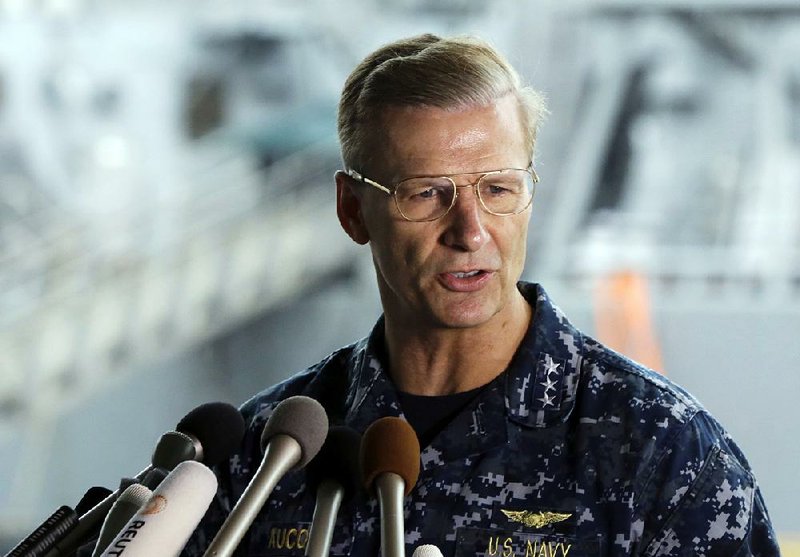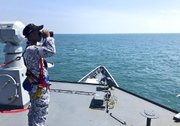The U.S. Navy on Wednesday relieved the admiral in charge of the service's 7th Fleet based in Japan over a "loss of confidence in his ability to command," it said in a statement.
The move follows four incidents in the Pacific since late January, including two collisions that left sailors dead and missing.
Adm. Scott Swift, commander of the U.S. Pacific Fleet, relieved Vice Adm. Joseph Aucoin from his duties at the 7th Fleet's Yokosuka base in Japan. Rear Adm. Phil Sawyer, the Pacific Fleet's deputy commander, will immediately take command. He had been scheduled to assume the post Sept. 7.
The incidents include Monday's deadly collision off Singapore of the destroyer USS John S. McCain with the Alnic MC, a Liberian-flagged oil and chemical tanker that is nearly three times the McCain's size. And in a June 17 collision, the destroyer USS Fitzgerald was ripped open by a larger, Japanese container ship.
Seven sailors were killed in the Fitzgerald disaster, and at least some of the 10 sailors reported missing from the McCain are feared dead, Swift said Tuesday.
Aucoin had been the 7th Fleet commander since September 2015, and he was previously the deputy chief of naval operations for warfare systems. His removal, first reported by The Wall Street Journal, is the most high-profile in the Navy since the disasters occurred.
The collisions have shocked the Navy, where good seamanship and avoiding collisions are fundamental to its operations. Adm. John Richardson, the chief of naval operations, announced Monday that he is ordering an "operational pause" across the globe in which commanders take a day or two to make sure that sailors understand the tenets of good seamanship.
Richardson also directed a four-star officer, Adm. Phil Davidson of Fleet Forces Command, to open a separate review of the 7th Fleet over the next few months to assess its culture, operations and readiness for missions.
Swift, who oversees the 7th Fleet as part of his role as Pacific Fleet commander, expanded the scope of that scrutiny Tuesday, ordering a second step to Richardson's review that will include all Navy forces in the Pacific. It will include a "deliberate reset" for ships that focuses on navigation, maintaining mechanical systems and manning the ship's bridge appropriately, Swift said.
So far this year, the fleet has faced four accidents that together have prompted questions about whether the sailors are being properly trained and supported. In addition to the Fitzgerald and McCain incidents, the guided-missile cruiser Lake Champlain on May 9 collided with a South Korean fishing vessel. On Jan. 31, the guided-missile cruiser Antietam ran aground in Tokyo Bay.
The 7th Fleet has headquarters in Yokosuka, Japan, and is responsible for an area that spans 36 maritime countries and 48 million square miles in the Pacific and Indian oceans, according to the Navy. The fleet has 50 to 70 ships assigned to it, including about a dozen at sea at any time. The force's missions range from responding to natural disasters to countering North Korean threats and Chinese audaciousness in the South China Sea, where Beijing has established new military bases.
"I think it's important to note that the 7th Fleet is out there all the time, and it has been since World War II ended," said retired Vice Adm. Peter Daly, the chief executive officer of the U.S. Naval Institute. "It has been heel-to-toe. It has been ships there all the time, and ships deploying there all the time to augment the ships that are already there."
Daly, who commanded everything from destroyers to carrier strike groups, said the recent incidents have highlighted what appears to be a disparity between how well ships that are based in Japan perform, as compared with the performance of ships that are based in the continental United States or Hawaii. The difference, Daly said, has sparked "a healthy concern" about why there is a difference between the two.
The unusual nature of the disasters even has prompted speculation that sabotage or a cyberattack may have been to blame, but senior Navy leaders have rebutted such theories. There is no indication that either occurred, Swift said Tuesday.
The scrutiny comes as the Navy remains mired in a corruption scandal in which Malaysian defense contractor "Fat" Leonard Francis offered prostitutes, cash, gifts and other favors in exchange for information as he made hundreds of millions of dollars from the Navy. At least 19 defendants have been convicted, with at least 10 more cases pending.
There's another issue at play, according to Daly and another 7th Fleet veteran, Scott Cheney-Peters. Years of the Navy reducing its number of ships has taxed the crews of those on the remaining vessels as the Navy does more with less, Cheney-Peters said.
"Although many of these ships are more capable than their predecessors from the early 1990s, at some point the lower absolute number of ships taxes those remaining and their crews because they can only be in so many places and doing so many things at once," said Cheney-Peters, who served on the Fitzgerald and later founded the Center for International Maritime Security, which facilitates discussion of naval matters.
"When I served in 7th Fleet aboard Fitzgerald a decade ago, the culture was of getting the mission done and taking care of your people, and only then taking care of yourself," he said. "This is how it should be, but usually there wasn't much time left for taking care of yourself, including for sleep."
FAMILIES IDENTIFY SAILORS
The 7th Fleet said in a statement Wednesday that Navy and Marine Corps divers are continuing to search the flooded compartments in the McCain in the hope of finding more of the missing sailors. The sea-based search east of Singapore "is expanding to encompass a greater area as time goes on," it said.
Singapore's government said the search area more than doubled Wednesday to about 2,120 square miles and that the search included assistance from aircraft and vessels deployed by the U.S., Singapore, Malaysia, Indonesia and Australia.
At least five of the 10 missing sailors have been identified by relatives.
Crew member Logan Palmer is from the Decatur, Ill., area and his mother identified him as missing, said U.S. Rep. Rodney Davis, R-Ill.
April Brandon in Michigan said the military informed her that her son, Ken Smith, is missing. She said Smith's father, stepmother and grandfather served in the Navy. Brandon said, "His father and I couldn't be prouder of our son."
The family of Jacob Drake of Ohio was told that he was among the missing, The Columbus Dispatch reported. Megan Partlow said Drake was her fiance and that she last had contact with him Sunday in a text message.
Family members of Dustin Doyon from Connecticut confirmed that he was among the missing. Police said the Navy was in communication with the family.
A Texas woman said her son, John Hoagland, was among the missing and had served aboard the warship since October.
Separately Wednesday, the Navy announced that the Fitzgerald will be transported to the shipyard in Pascagoula, Miss., to be repaired at Ingalls Shipbuilding, part of Huntington Ingalls Industries of Newport News, Va.
Naval Sea Systems Command said it doesn't know when work will start, how long it will take, or how much it will cost. The command said it chose Ingalls because it determined that only a shipyard that builds destroyers could fix the damage from the collision with the Philippine-flagged container ship, which caved in parts of the Fitzgerald above and below the waterline. Water gushed into berthing compartments, killing the sailors.
The Navy said it will use the opportunity to modernize the Fitzgerald, which had been scheduled for an overhaul in the 2019 budget year. A Navy spokesman couldn't immediately say how much those overhauls typically cost on an undamaged ship.
The Navy said it is considering proposals to hire a heavy-lift ship to carry the Fitzgerald to Pascagoula from Yokosuka, where it's dry-docked.
The Navy said last week that the Fitzgerald's captain was being relieved of his command and other sailors were being punished after poor seamanship and flaws in keeping watch were found to have contributed to its collision. An investigation into how and why the Fitzgerald collided with the other ship was not finished, but enough details were known to take those actions, the Navy said.
Information for this article was contributed by Dan Lamothe of The Washington Post; by Ken Moritsugu, Lolita Baldor, Robert Burns and Jeff Amy of The Associated Press; and by W.J. Hennigan of Tribune News Service.
A Section on 08/24/2017

